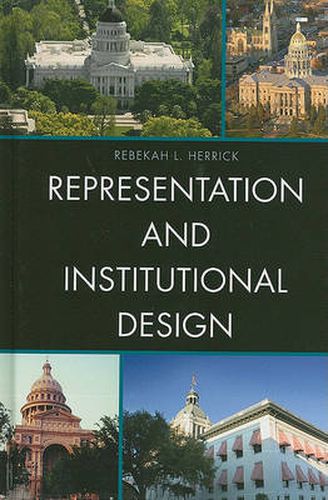Readings Newsletter
Become a Readings Member to make your shopping experience even easier.
Sign in or sign up for free!
You’re not far away from qualifying for FREE standard shipping within Australia
You’ve qualified for FREE standard shipping within Australia
The cart is loading…






An enduring question for most nations has been how to best represent their citizens and their needs. This is a complex issue as there is no universally accepted definition of good representation. Representation and Institutional Design addresses the issues of institutions and representation by examining how variation in institutional design can affect many aspects of how legislators represent their constituents. It does so by examining the relationships between legislative design (electoral laws, term limits, professionalism, and district size and magnitude) and many aspects of representation (symbolic, service, and policy representation, as well as legislators’ incentives to represent). A key finding is that each aspect of professionalism has a unique set of effects on representation. Legislators with staff have closer relationship with their constituents than others. Legislators with other legislative resources engage in more symbolic and service representation but not policy representation. And legislators in institutions with greater capacity were similar to others in their representative style. Findings also indicate that term limits weaken relationships between legislators and constituents and electoral laws, and district size and magnitude have some but limited effects. This is an important study not only because of the importance of representation but also because of the dearth of research on how institutional design affects representation in state legislatures.
$9.00 standard shipping within Australia
FREE standard shipping within Australia for orders over $100.00
Express & International shipping calculated at checkout
An enduring question for most nations has been how to best represent their citizens and their needs. This is a complex issue as there is no universally accepted definition of good representation. Representation and Institutional Design addresses the issues of institutions and representation by examining how variation in institutional design can affect many aspects of how legislators represent their constituents. It does so by examining the relationships between legislative design (electoral laws, term limits, professionalism, and district size and magnitude) and many aspects of representation (symbolic, service, and policy representation, as well as legislators’ incentives to represent). A key finding is that each aspect of professionalism has a unique set of effects on representation. Legislators with staff have closer relationship with their constituents than others. Legislators with other legislative resources engage in more symbolic and service representation but not policy representation. And legislators in institutions with greater capacity were similar to others in their representative style. Findings also indicate that term limits weaken relationships between legislators and constituents and electoral laws, and district size and magnitude have some but limited effects. This is an important study not only because of the importance of representation but also because of the dearth of research on how institutional design affects representation in state legislatures.